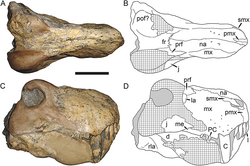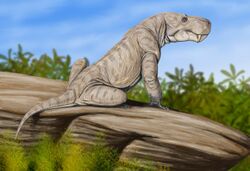Biology:Dinogorgon
| Dinogorgon | |
|---|---|

| |
| Holotype skull of D. rubidgei | |
| Scientific classification | |
| Domain: | Eukaryota |
| Kingdom: | Animalia |
| Phylum: | Chordata |
| Clade: | Synapsida |
| Clade: | Therapsida |
| Clade: | †Gorgonopsia |
| Family: | †Gorgonopsidae |
| Tribe: | †Rubidgeini |
| Genus: | †Dinogorgon Broom, 1936 |
| Type species | |
| †Dinogorgon rubidgei Broom, 1936
| |
| Synonyms | |
| |
Dinogorgon is a genus of gorgonopsid from the Late Permian of South Africa and Tanzania. The generic name Dinogorgon is derived from Greek, meaning "terrible gorgon", while its species name rubidgei is taken from the surname of renowned Karoo paleontologist, Professor Bruce Rubidge, who has contributed to much of the research conducted on therapsids of the Karoo Basin. The type species of the genus is D. rubidgei.
Dinogorgon is part of the gorgonopsian subfamily Rubidgeinae, a derived group of large-bodied gorgonopsians restricted to the Late Permian (Lopingian). The Rubidgeinae subfamily first appeared in the Tropidostoma Assemblage Zone, and reached their highest diversity in the Cistecephalus and Daptocephalus assemblage zones of the Beaufort Group in South Africa .[1][2][3][4]
History of discovery
The type species of Dinogorgon rubidgei was discovered on Wellwood farm, a farm owned by the grandfather of Bruce Rubidge, Sidney H. Rubidge, outside of Graaff-Reinet. The fossil was likely recovered by Haughton himself sometime in the 1930s or 1940s, and were only described by British paleontologist, Sidney H. Haughton, and James Kitching between 1953 and 1965.[5][6][7]
Description
Dinogorgon was one of the largest species of rubidgeinae, with the skull length of nearly 40 centimetres (16 in), almost as large as Rubidgea had.[8] It was a formidable predator, and likely preyed on reptiles and smaller therapsids.[9][10] Like more derived rubidgeines, Dinogorgon had a number of bosses on its skull, likely to reduce the stresses caused by struggling prey. Its snout was deep but narrow, similar to Aelurognathus,[11] but narrower than Rubidgea and Clelandina. It had 4 to 5 upper and lower postcanine teeth, which further distinguishes it from Rubidgea.[12][13] Three subspecies are currently recognized in the genus: D. rubidgei, D. quinquemolaris, and D. pricei.
Classification
The Rubidgeinae are a subfamily of derived gorgonopsids that have only been found in Africa. They are composed of six genera and 17 species. The Rubidgeinae are closely related to their sister group, the Inostranceviinae, which have only been found in Russia . Out of the gorgonopsian clade, the systematics of the Rubidgeinae are the best resolved due to their distinctive character traits. The systematics of other gorgonopsian subfamilies remain chaotic due to a high degree of cranial homomorphism between taxa, making it difficult to distinguish different taxa effectively.[14][15][16][17][18]
Dinogorgon shares many characteristics with Rubidgea and Clelandina, which has led some authors to synonymize them. All three are now considered to be part of the same tribe, Rubidgeini, rather than the same genus. The cladogram below (Kammerer et al. 2016) displays currently accepted systematic relationships of the Gorgonopsia.
| Gorgonopsia |
| |||||||||||||||||||||||||||||||||||||||||||||||||||||||||||||||||||||||||||
Palaeoenvironment
Numerous therapsid species, including rubidgenae gorgonopsids, are used as biostratigraphic markers in other African basins, such as the Upper Madumabisa Mudstone of Zambia, the Usili Formation of Tanzania, and the Chiweta Beds of Malawi.[19]
References
- ↑ Viglietti, P.A., Smith, R.M., Angielczyk, K.D., Kammerer, C.F., Fröbisch, J. and Rubidge, B.S. (2016-10-10). "The Daptocephalus Assemblage Zone (Lopingian), South Africa: a proposed biostratigraphy based on a new compilation of stratigraphic ranges". Journal of African Earth Sciences 113: 153–164. doi:10.1016/j.jafrearsci.2015.10.011. Bibcode: 2016JAfES.113..153V.
- ↑ Nicolas, Merrill; Rubidge, Bruce S. (2010). "Changes in Permo-Triassic terrestrial tetrapod ecological representation in the Beaufort Group (Karoo Supergroup) of South Africa" (in en). Lethaia 43 (1): 45–59. doi:10.1111/j.1502-3931.2009.00171.x. ISSN 1502-3931. Bibcode: 2010Letha..43...45N.
- ↑ Kammerer, Christian F. (2015). "Cranial osteology of Arctognathus curvimola, a short-snouted gorgonopsian from the Late Permian of South Africa" (in en). Papers in Palaeontology 1 (1): 41–58. doi:10.1002/spp2.1002. ISSN 2056-2802.
- ↑ Kammerer, Christian F.; Smith, Roger M. H.; Day, Michael O.; Rubidge, Bruce S. (2015). "New information on the morphology and stratigraphic range of the mid-Permian gorgonopsian Eriphostoma microdon Broom, 1911" (in en). Papers in Palaeontology 1 (2): 201–221. doi:10.1002/spp2.1012. ISSN 2056-2802.
- ↑ Broom, Robert. "20. On a New Family of Carnivorous Therapsids from the Karroo Beds of South Africa." In Proceedings of the Zoological Society of London, vol. 108, no. 3, pp. 527-533. Oxford, UK: Blackwell Publishing Ltd, 1938.
- ↑ Kitching, J.W., 1953. Studies on new specimens of the Gorgonopsia.
- ↑ Haughton, S. H. (1965-12-01). "The Rubidge Collection of fossil Karroo vertebrates" (in en). Palaeontologia Africana. ISSN 0078-8554. http://wiredspace.wits.ac.za/handle/10539/16057.
- ↑ Frank Zachos, Robert Asher (October 22, 2018). Mammalian Evolution, Diversity and Systematics. De Gruyter. p. 158-159. ISBN 9783110341553. https://books.google.com/books?id=dQd2DwAAQBAJ. Retrieved 9 September 2022.
- ↑ Cruickshank, A. R. I. (1973). "THE MODE OF LIFE OF GORGONOPSIANS" (in en). Palaeontologia Africana. ISSN 0078-8554. http://wiredspace.wits.ac.za/handle/10539/16039.
- ↑ Jenkins, Ian; Valkenburgh, Blaire Van (2002-10-01). "Evolutionary Patterns in the History of Permo-Triassic and Cenozoic Synapsid Predators" (in en). The Paleontological Society Papers 8: 267–288. doi:10.1017/S1089332600001121. ISSN 1089-3326.
- ↑ Norton, Luke Allan (2013-02-01). Relative growth and morphological variation in the skull of Aelurognathus (therapsida: gorgonopsia) (Thesis thesis).
- ↑ Kemp T. S.; Parrington Francis Rex (1969-09-04). "On the functional morphology of the gorgonopsid skull". Philosophical Transactions of the Royal Society B: Biological Sciences 256 (801): 1–83. doi:10.1098/rstb.1969.0036. Bibcode: 1969RSPTB.256....1K.
- ↑ Martins, Rui M. S.; Fröbisch, Jörg; Polcyn, Michael J.; Fernandez, Vincent; Araujo, Ricardo M. (2017-02-21). "Aspects of gorgonopsian paleobiology and evolution: insights from the basicranium, occiput, osseous labyrinth, vasculature, and neuroanatomy" (in en). PeerJ 5: e3119. doi:10.7717/peerj.3119. PMID 28413721.
- ↑ Kermack, Doris M.; Kermack, Kenneth A. (1984), Kermack, Doris M.; Kermack, Kenneth A., eds., "Dentitions, Tooth-Replacement and Jaw Articulation" (in en), The Evolution of Mammalian Characters (Springer US): pp. 66–88, doi:10.1007/978-1-4684-7817-4_5, ISBN 9781468478174
- ↑ Sigogneau, D. (1968). "On the classification of the Gorgonopsia" (in en). Palaeontologia Africana. ISSN 0078-8554. http://wiredspace.wits.ac.za/handle/10539/16116.
- ↑ Sigogneau-Russell, D., 1989. Theriodontia 1: Phthinosuchia, Eotitanosuchia, Gorgonopsia.
- ↑ Gebauer, Eva V. I. (2014), "Re-assessment of the Taxonomic Position of the Specimen GPIT/RE/7113 (Sauroctonus parringtoni comb. Nov., Gorgonopsia)", in Kammerer, Christian F.; Angielczyk, Kenneth D.; Fröbisch, Jörg (in en), Early Evolutionary History of the Synapsida, Vertebrate Paleobiology and Paleoanthropology, Springer Netherlands, pp. 185–207, doi:10.1007/978-94-007-6841-3_12, ISBN 9789400768413
- ↑ Kammerer, Christian F. (2016-01-26). "Systematics of the Rubidgeinae (Therapsida: Gorgonopsia)" (in en). PeerJ 4: e1608. doi:10.7717/peerj.1608. ISSN 2167-8359. PMID 26823998.
- ↑ Parrington, F. R. (1974). "A new genus of gorgonopsid from East Africa". Annals of the South African Museum 64: 47–52.
Wikidata ☰ Q280846 entry
 |



